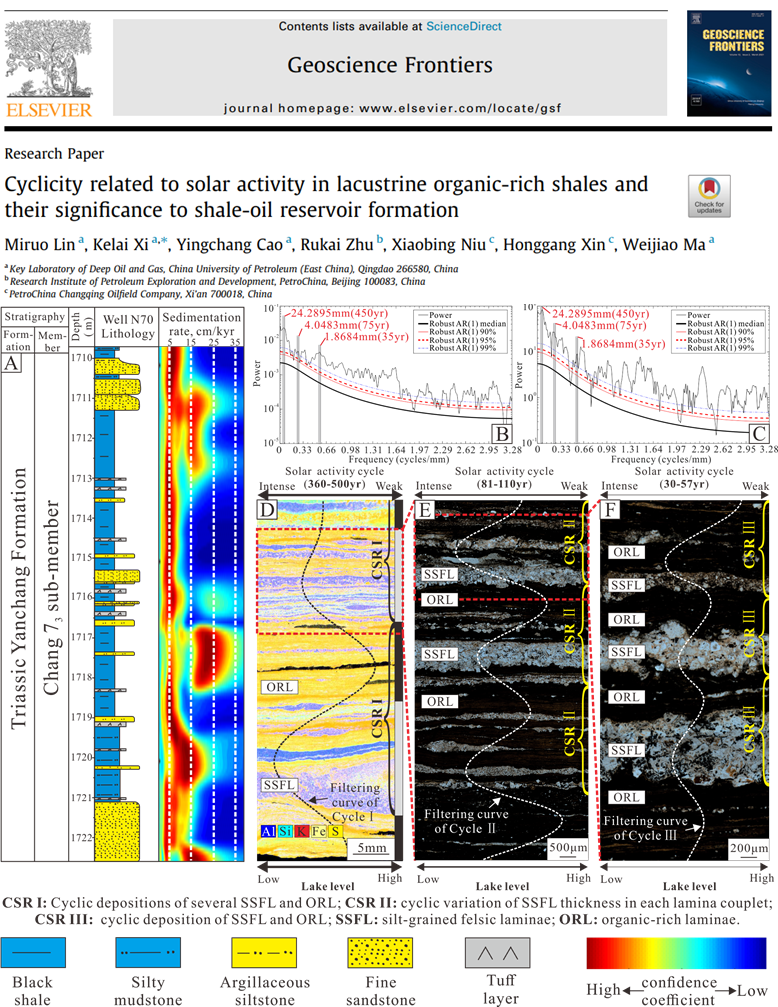Abstract
The formation mechanism of micron-to centimeter-scale sedimentary cycles in lacustrine shales is a hot topic of research,because these small-scale sedimentary cycles significantly influence shale-oil distribution heterogeneity.High-frequency paleoenvironmental evolution is an important controlling factor for the formation of small-scale sedimentary cycles.However,the driving factors of high-frequency paleoenvironmental evolution and the formation process of sedimentary cycles under its constraint remain speculative.In this study,which focuses on lacustrine shales,we find that the alternating deposition of variable thickness of organic-rich lamina(ORL)and silty-grained felsic lamina(SSFL)form sedimentary cycles on the micron to centimeter scale in the Chang 73 sub-member of the Yanchang Formation in the Ordos Basin.Based on detailed petrographic characterization,in-situ geochemical parameter testing,and high-resolution cycle analysis,the formation process of cyclical sedimentary records and related paleoenvironmental evolution are investigated.Three solar activity cycles were identified from the shales,namely the 360–500 yr,81–110 yr,and 30–57 yr cycles(cycles I,II,and III,respectively).Highfrequency paleoenvironmental evolution caused by solar activity induced lake-level fluctuation,which further controlled silty-grained sediment deposition and organic matter preservation in deep lake areas.Cycle I controlled relatively long-term lake-level fluctuation,driving several pairs of SSFL and ORL deposition at the centimeter scale.Cycles II and III were short-term cycles and acted on the millimeter to micrometer scale,further complicating the sedimentary strata forming during the period of lake-level fall induced by cycle I.The cyclic deposition of SSFL and ORL correspond to cycle III.Lake-level fluctuation influenced by cycle II mainly caused SSFL thickness variation in each lamina couplet.During the period of lake-level rise induced by cycle I,periods of lake level rise during cycles II,and III show cyclic variation in reducibility,and are not thought to control the supply of coarse-grained sediments in to the deep lake areas.Frequent lake-level fluctuation promotes lamina couplet formation in thickly-bedded shales,which creates favorable conditions for shale-oil accumulation.Oil produced from ORL can migrate-locally into dissolved feldspar porosity in SSFL and therefore is able to accumulate in shales,which creates high potential for future oil exploration in thickly-bedded lacustrine shales.

Paper Information:
Mi-Ruo Lin, Ke-Lai Xi*, Ying-Chang Cao, Ru-Kai Zhu, Xiao-Bing Niu, Hong-Gang Xin, Wei-Jiao Ma, 2023. Cyclicity related to solar activity in lacustrine organic-rich shales and their significance to shale-oil reservoir formation. Geoscience Frontiers, https://doi.org/10.1016/j.gsf.2023.101586.

